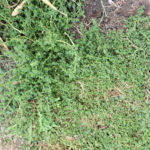Nasturtium – Tropaeolum majus
Description
- Nasturtium can be found wild as a garden escape
- it has beautiful round leaves that are thin, a bright green colour with main veins radiating from a central point and minor veins in between
- the long leaf stems are succulent and juicy snapping if you break them
- Nasturtium is a native of Peru and was brought to Europe in the 1500s by the Spanish conquistadors
- early on in Europe it was known as “Indian cress”
- the botanical name “Tropaeolum, is Greek for trophy, referring to the shield-like shape of the leaves and the helmet shape of the delicate flowers
- the plant is an annual (although in warm climates can grow during the winter, but is killed by frost)
- it creeps and climbs rapidly over and through other plants or walls and it can grow in poor soil
- the flowers are bright, bold colours of orange, red, yellow, and shades between
- They can be single or double
- I love the way the sun glows in the throat of the flowers. The extended bit at the base of the flower (you can see it sticking out to the right of the
 bud in the photo) is where the nectar is that bees go for and which is sweet for us to eat too
bud in the photo) is where the nectar is that bees go for and which is sweet for us to eat too - the leaves are cool to touch, but have a hot biting flavour when eaten, as do the flowers and the seeds
- it is related closely to watercress which has the same hot flavour.
Nutritional Qualities
- a tonic plant and a blood purifier.
- The heat stimulates appetite a treatment for intestinal worms
- Juliette de Baïracli Levy says it is an antiseptic for the blood and digestive system
- Juliette’s treatment for worms is to eat six to ten green seeds, while fasting night and morning
- it helps with nervous depression, tiredness, poor sight
- the seeds can be pickled in cider vinegar (like capers) spiced with cloves, bay leaves and sprigs of thyme (recipe below) I use the leaves, which I think look like lily pads of the air, in salads and smoothies (just a couple as the taste can overpower a smoothie)
- the flowers make salads look gorgeous and inviting to eat as decoration
(see right) this salad has a day lily in the centre which is totally edible as well I remember in my younger years having vegemite and nasturtium sandwiches for lunches at school.Another aspect of this plant – if you examine each leaf you’ll see a gold
rim around the edge like a halo – it seems like it is protective of itself and perhaps of us too. It is brimming with Vitamin C helping to combat colds and flu.
Nasturtium capers
Nasturtiums have seed pods that you can collect and pickle in cider vinegar and which taste similar to capers, but you’ve made it yourself. Fill a jar with seed pods and as you are putting them in add a couple of sprigs of thyme a bay leaf and some cloves – say six. Then fill the jar with cider vinegar and put the plastic lid on, (or put some plastic under the lid to stop the vinegar rusting it) label it with the date and leave for 4-6 weeks or until you like the taste. On the right in the photo are nasturtium capers that I made in a previous batch. Add them to salads or stews or casseroles.








Hi Julia.
I love your posts and the fact that you explain all the various ways you can use the weeds besides putting them in the smoothies. You are such a wonderful source of useful information as I can so do with more varieties of greens to eat.
Thank you for all the work you put in these posts and btw your workshop I attended some time ago was fun and also very helpful. You are very inspiring and before the frost gets them I will get some nasturtium capers. Wilma
HI Wilma, thank you so much for your message and for your feedback! I really appreciate you taking the time to write and I’m so glad you find the articles inspiring!!
HI Wilma, I love the image of your going out for an Easter Egg hunt to find cleavers!! The meatballs are a great snack and they freeze really well. I make a big batch eat some for breakfast and freeze some – and what I love is that they hold together so well without flour or egg or anything just meat and vegetables. I keep a lid on the pan when I cook them as the water comes out of them and they shrink, then they cook in the liquid and you have to watch that they don’t dry out and get over cooked. I’m getting the hang of making them now. Have fun! Thank you for writing – weeds are so beautiful. My interest and love for them keeps growing!
Hi Julia
Could you put your info on Fushias on your website that you covered sometime last year in your newsletter please?
Thanks
Fiona
And to think I’ve been ‘cursing’ biddy biddy (cleavers) all these years as I pull it from my garden… Now onto the dinner plate it goes ! Thankyou for all your useful information.